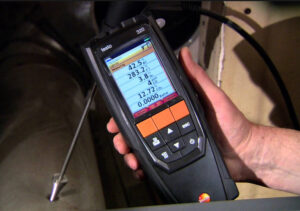Written on: March 6, 2018 by George Carey
The heating industry, for the past decade, has focused on improving the combustion or thermal efficiencies of the boiler. Every major boiler manufacturer has a series of modulating/condensing boilers in its product offering. The number of mod/con boiler installations has been growing every year and is expected to continue to grow. Some of the boilers, when installed in the right application, are achieving efficiencies in the 95% + range. People in our industry are under the impression that with thermal efficiencies this high, there isn’t any room left for improving a hydronic heating system. Their thinking would be correct if combustion efficiency was the only goal. However, there is another efficiency that the industry had ignored for years but is starting to look at and that’s the hydraulic efficiency of the distribution system. We should be looking at overall system efficiency which includes how efficient the boiler plant converts fuel into heated system water and how efficiently this heated water is delivered to the building?
First, let’s define what distribution efficiency is:
EFFICIENCY
Desired OUTPUT quantity/ necessary
INPUT quantity.
In basic terms, how much energy is needed to get the desired output? When we apply the definition of distribution efficiency to a heating system, it looks like this:
DISTRIBUTION EFFICIENCY
rate of heat delivery/ rate of energy use by
distribution equipment.
If a heating system provides 120,000 BTU/H at outdoor design conditions and they have four circulators that consume 90 watts each, the distribution efficiency for that system is:
DISTRIBUTION EFFICIENCY
120,000 Btu/h/ 360 watts
= 333Btu/h / watt
Compare that to a warm air furnace where the blower motor consumes 1,050 watts while delivering 110,000 Btu/h through the duct system. The distribution efficiency for that system would be:
DISTRIBUTION EFFICIENCY
110,000 Btu/h / 1050 watts
= 105 Btu/h / watt
The hydronic system has a higher distribution efficiency than the warm air furnace because the physical properties of water are much better for conveying heat than air.
Even though hydronic systems generally have a higher Distribution Efficiency than air systems, when the number of pumped zones increases, the distribution efficiency can quickly dissolve. For example, I recently visited one of those “McMansions” where they had 34 zones, all with water lubricated circulators consuming 90 watts each. The house had a design load of 350,000 Btu/hr. When you run the numbers to determine the distribution efficiency:
DISTRIBUTION EFFICIENCY
350,000 Btu/hr / 34 x (90 watts)
= 114 Btu/hr / watt
As you can see, a hydronic system, when taken to the extreme, can become an inefficient distribution system. These systems have been installed for years with no real concern for operating costs. However, as energy costs continue to rise, not only has it impacted both fuel costs for transportation and heating homes, but also electrical costs. Power plants that produce electricity have to use some source of energy. The majority has used coal for years, but through legislation many plants are being closed down or converted to natural gas. This is putting tremendous pressure on the ability for the power plants to manufacture electricity. The result? Higher electric bills! In Europe, where they have experienced higher fuel and electric costs, they were forced to come up with better and more efficient ways to heat the water and deliver the heated water to the heating terminal units. One of the technologies they have embraced for the past 15 years is electronically commutated magnetic motors, known as ECM. The majority of residential homes in Europe use hot water heating to warm their homes. To achieve higher distribution efficiencies they have incorporated ECM technology into their circulators. In fact, nowadays only ECM circulators are allowed to be installed in Europe. The pump manufacturers their have combined their efforts to improve the efficiency of the circulators they offer for hot water heating systems. They came up with an efficiency index that the all of the pump manufacturers had to reach: Energy Efficiency Index (EEI). The European Community recently created legislation to adopt EEI. While trying to reach these efficiency standards, the manufacturers quickly realized they could not achieve the necessary efficiency points with induction motor technology. It just proved to be too inefficient so they moved to ECM motor technology.

Utilities in the U.S. Northeast are providing rebate incentives for residential ECM circulators. It seems they are very interested in having the hydronic industry move away from the old, inefficient induction motors and move towards ECM technology. Plumbing and heating wholesale distributors sign up and become part of the Utility’s high-performance circulator program. They then can offer a $100 discount off the price of any of the participating ECM residential circulators. Why would they provide such a generous incentive? It has to do with energy costs and energy consumption. As energy costs continue to rise, the impact affects everyone. Production costs go up, distribution costs go up and the net result is higher utility bills for the end user.
If we were to re-examine our Distribution Efficiency formula while incorporating the new ECM circulators that can consume considerably less watts, the distribution efficiency can be markedly improved. If we go back to that McMansion that had 34 water lubricated zone pumps and replaced them with the ECM pumps with speed control (that allows the pump to be set for the zone’s actual load), the formula would look something like this:
DISTRIBUTION EFFICIENCY
350,000 Btu/hr / 34 x (20 watts)
= 515 Btu/hr / watt
If you have any questions or comments, e-mail gcarey@fiainc.com, call 1-800-423-7187 or follow me on Twitter at @Ask_Gcarey ICM